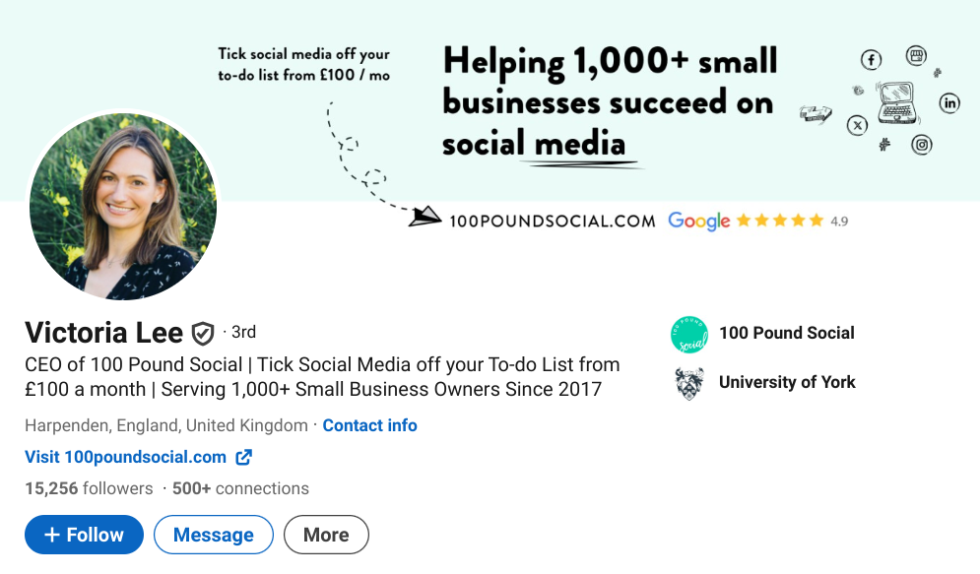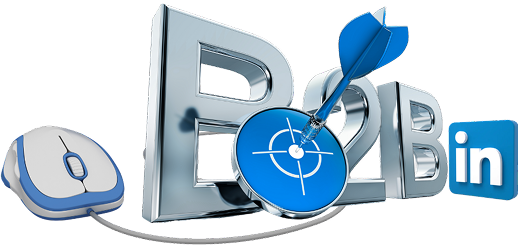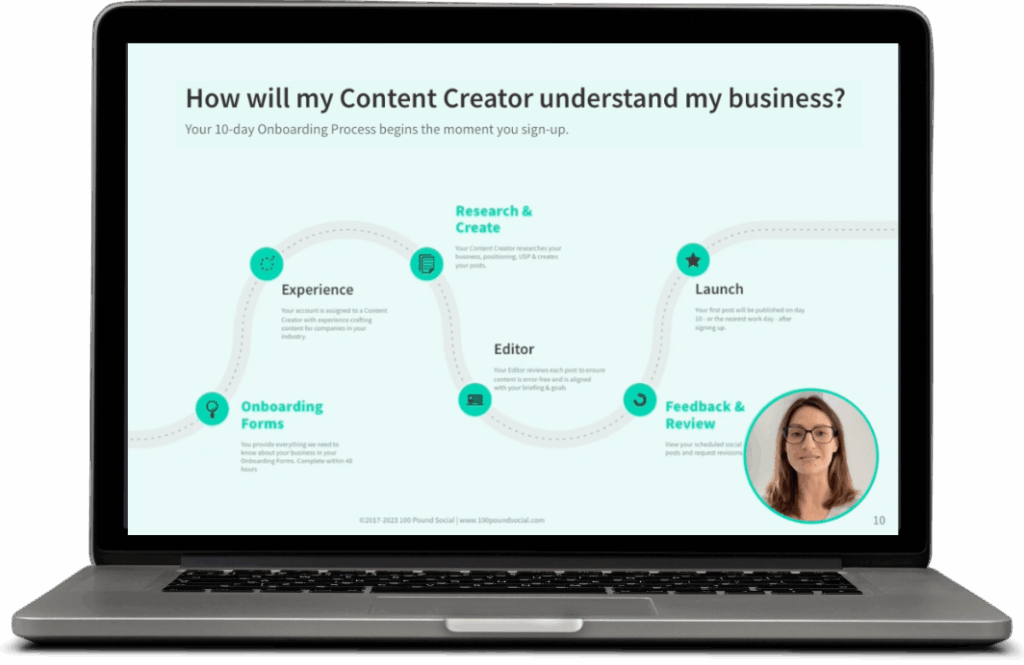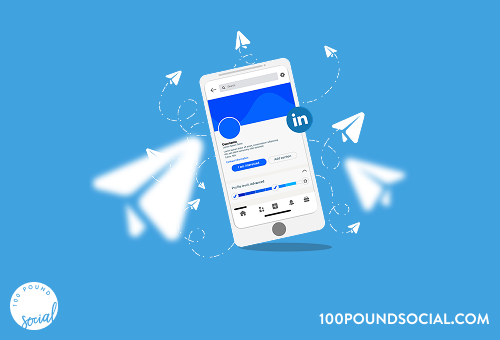B2B LinkedIn marketing has transformed from a simple networking tool into the most powerful platform for reaching decision-makers and generating quality leads.
For small businesses operating in the B2B space, LinkedIn offers unmatched access to industry leaders, potential clients, and professional communities actively seeking business solutions.
Many small B2B firms struggle to make a meaningful impact on LinkedIn due to limited marketing budgets, small teams with competing priorities, overwhelming competition from larger brands, and a lack of clear strategy and direction.
This guide provides actionable, affordable strategies specifically designed for small B2B businesses. You’ll learn how to build authority, generate quality leads, and grow your business presence without breaking the bank.
Download Our FREE Guide to Generating Hot Leads on LinkedIn →
Why LinkedIn Is a B2B Game-Changer
LinkedIn isn’t just another social platform—it’s where business decisions happen. With over 900 million users and 55 million businesses actively using the platform, LinkedIn has become the digital equivalent of the world’s largest business conference, running 24/7.
The statistics paint a compelling picture for B2B marketers. LinkedIn drives more than 80% of social media leads for B2B companies.
But what makes LinkedIn truly special for B2B marketing isn’t just its size—it’s the quality and intent of its audience.
Unlike other social platforms where users might be browsing casually, LinkedIn users are in a professional mindset. They’re actively seeking industry insights, networking opportunities, and business solutions. This means your content and messaging reach people who are already thinking about work-related challenges and opportunities.
The platform’s sophisticated targeting capabilities allow you to zero in on specific industries, company sizes, job roles, and geographic locations with remarkable precision. Whether you’re targeting CFOs at mid-sized manufacturing companies or marketing directors in the technology sector, LinkedIn’s advanced search and targeting features ensure your message reaches exactly the right people.
For small B2B businesses, this targeting precision is particularly valuable. Rather than casting a wide net and hoping for the best, you can focus your limited resources on reaching the prospects most likely to convert into customers. This efficiency makes LinkedIn an ideal platform for companies operating with tight marketing budgets.
Optimise Your Company Page
Company Page Essentials
Your LinkedIn Company Page serves as your digital headquarters and often provides the first impression potential clients will have of your business. Start with visual branding that immediately communicates your value proposition.
Your banner image should reflect what your business does rather than generic stock photography, while your logo maintains consistency when doing LinkedIn marketing for B2B.
The company description deserves special attention as it serves multiple SEO purposes.
Think about what your ideal clients are searching for and incorporate those terms organically throughout your description.
Don’t overlook completing every profile section, as this significantly impacts both credibility and discoverability. Include all business locations, website URL, contact information, industry classification, company size, and areas of specialisation.
The custom call-to-action button should direct visitors toward your primary business objective, whether that’s generating leads, driving website traffic, or encouraging direct contact.
Personal Profile Strategy

Personal profiles often generate higher engagement than company pages due to LinkedIn’s algorithm favouring individual users. Focus on optimising profiles of key team members, particularly founders, sales leaders, and subject matter experts.
These profiles should feature professional headshots, compelling summaries that highlight both personal expertise and company affiliation, and complete experience sections that build credibility.
Network building requires a strategic approach rather than connecting with anyone and everyone. Focus on building relationships with industry peers, potential clients, referral partners, and thought leaders in your space.
Personal invitations that mention common connections, shared interests, or specific reasons for connecting work far better than generic requests.
Share your own insights and perspectives through personal posts. This content often feels more authentic than corporate messaging, helping to humanise your brand while extending your reach. The key is maintaining a balance between personal and professional content without becoming purely promotional channels.
Build Authority with Strategic Content
Content is where small B2B businesses can truly level the playing field on LinkedIn. While you might not have the advertising budget of larger competitors, you can absolutely match or exceed their content quality and engagement levels.
The secret lies in understanding what your audience actually wants and consistently delivering value.
High-Performing Content Types
Educational Content:
- Industry insights and trend analysis
- How-to guides solving common problems
- Best practice recommendations
- Tool and resource recommendations
Social Proof Content:
- Client success stories and case studies
- Testimonials and reviews
- Project showcases and results
- Awards and recognition highlights
Behind-the-Scenes Content:
- Process demonstrations
- Company milestone celebrations
- Day-in-the-life content
Content Format Optimisation
Visual content performs exceptionally well on LinkedIn, with images receiving significantly higher engagement than text-only updates.
Writing for LinkedIn requires clear, scannable formatting that respects busy professionals’ time. Use compelling hooks in opening lines, include relevant hashtags (maximum four per post), and always include a call-to-action that encourages meaningful engagement rather than generic likes.
Consistency matters more than perfection when building your LinkedIn presence.
Companies that post weekly see double the engagement of those who post sporadically, while daily posting can drive even better results. However, quality should never be sacrificed for quantity—it’s better to share one valuable post per week than five mediocre ones.
Maximise Personal Profiles for Reach
While your company page establishes your business presence, personal profiles often drive more engagement and reach on LinkedIn. The platform’s algorithm tends to favour content from individual users, making personal profiles powerful amplifiers for your business message.
Focus on optimising the profiles of key team members, particularly founders, sales leaders, and subject matter experts.
These profiles should look professional and complete, with clear headshots, compelling summaries that highlight both personal expertise and company affiliation, and relevant experience that builds credibility.
Growing a targeted network requires a strategic approach. Rather than connecting with anyone and everyone, focus on building relationships with industry peers, potential clients, referral partners, and thought leaders in your space.
Personal invitations that mention common connections, shared interests, or specific reasons for connecting work far better than generic requests.
For solo business owners, focus on building your personal brand alongside your company presence. Your personal posts about industry insights, business challenges, and professional experiences often generate higher engagement than company page content.
When you share company updates or insights from your personal profile, you’re providing authentic endorsements that carry significant weight with your network.
The key is maintaining a balance between personal and professional content. While these profiles should support business objectives, they shouldn’t become purely promotional channels.
The most effective approach involves sharing genuine insights, engaging in meaningful conversations, and building real relationships rather than simply broadcasting sales messages.
Let Us Take Care of Your LinkedIn Lead Generation, From £254/Mo →
Smart Paid Strategy (Even on a Small Budget)
Budget-Friendly Advertising Options
Sponsored Content offers an excellent starting point for small businesses, allowing you to amplify your best-performing organic posts to targeted audiences. Focus on content that has already proven successful organically, then extend its reach to prospects who haven’t discovered your business yet.
Message Ads provide direct access to prospects’ LinkedIn inboxes with personalised messaging for higher response rates. This format works particularly well for lead generation when you offer clear value propositions and avoid overly sales-focused language in initial outreach.
LinkedIn’s minimum budget requirements are more accessible than many small businesses realise. You can start with as little as £8 per day for any ad format, making it possible to test campaigns with a monthly spend of just £240.
LinkedIn recommends starting with £20-40 per day for new advertisers to allow their algorithm sufficient data to optimise your campaigns effectively. This translates to a monthly testing budget of £600-1,200, but you can absolutely start smaller and scale up as you see results.
Focus initially on retargeting warm audiences—people who have visited your website, engaged with your content, or match your ideal customer profile. Strategic budget allocation combined with narrow targeting typically delivers better ROI than broad campaigns, allowing smaller budgets to compete effectively.
Advanced Targeting Techniques
LinkedIn’s targeting capabilities are sophisticated, allowing small businesses to compete with larger competitors through precision rather than budget size. The key is focusing your limited resources on the prospects most likely to convert into customers.
Audience Segmentation:
- Job title and seniority level targeting
- Company size and industry filtering
- Geographic location specification
- Specific company targeting for dream clients
Retargeting Strategy:
- Website visitors from previous campaigns
- Content engagers from organic posts
- Email list uploads for custom audiences
- Lookalike audiences based on the best customers
Campaign Optimisation:
- Set clear goals for each campaign
- Monitor performance metrics closely
- Pause underperforming campaigns quickly
- Reallocate budget to successful elements
This focused approach typically delivers better ROI than broad campaigns, as warm audiences convert at much higher rates than cold prospects. Remember to measure everything and be prepared to adjust quickly based on performance data.
LinkedIn Engagement That Pays Off

Developing consistent daily engagement habits drives visibility and establishes expertise more effectively than sporadic activity.
Spend 15-20 minutes each day commenting thoughtfully on posts from industry leaders, potential clients, and peers. Your comments should add genuine value to conversations rather than generic responses or self-promotion.
Responding promptly to comments on your own content shows you value audience input and helps extend conversations. LinkedIn’s algorithm interprets ongoing engagement as a signal of quality content worth showing to more people, amplifying your organic reach.
LinkedIn Groups offer valuable opportunities when chosen strategically. Focus on groups where your ideal clients are active and meaningful discussions take place. Participate genuinely by answering questions and sharing insights rather than promoting services directly.
Relationship Building Techniques
Send personalised connection requests that mention common interests or specific reasons for connecting, and maintain regular contact with your network by offering help before asking for favours. The goal of all engagement should be building relationships rather than making immediate sales.
Strategic use of hashtags can help your content join broader industry conversations. Use up to four relevant hashtags per post, focusing on terms your target audience follows. Research which hashtags are popular in your industry and experiment with both broad and niche options.
Focus on being helpful, providing value, and establishing yourself as a knowledgeable resource. Sales opportunities often develop naturally from these authentic connections when you’ve built trust and demonstrated expertise over time.
Tracking What Works
Focus on metrics that directly relate to business objectives rather than vanity numbers. Track post engagement, including likes, comments, and shares, but pay special attention to click-through rates to your website and actual enquiries generated. Profile views, connection requests, and follower growth indicate increasing visibility, but lead generation metrics like website traffic from LinkedIn, form submissions, and meeting requests provide clearer business value.
LinkedIn’s native analytics provide valuable insights into company page performance, individual post engagement data, and audience demographics. Tools like HeyOrca can help streamline content planning and performance tracking, while Google Analytics shows how LinkedIn traffic converts on your website.
Conduct monthly analysis to review top-performing content types, analyse audience engagement patterns, and identify optimal posting times. Quarterly strategy adjustments should refine your content approach based on data, update targeting for paid campaigns, and set new benchmarks for success.
Focus on trends rather than individual post performance, as consistent patterns reveal what truly resonates with your audience.
Key Takeaways
LinkedIn offers unparalleled opportunities for B2B growth, regardless of company size. Success doesn’t depend on massive budgets or large teams—it’s about consistency, authenticity, and genuine commitment to providing value to your audience.
Core Success Factors:
- Consistent, value-driven content creation
- Strategic engagement with target audiences
- Professional optimisation of all profiles
- Data-driven approach to campaign management
- Long-term relationship building focus
Competitive Advantages for Small Businesses:
- Authenticity over polished corporate messaging
- Personal relationships and direct access to decision-makers
- Agility to respond quickly to market changes
- Specialised expertise in niche areas
- Genuine engagement rather than automated interactions
Next Steps
Developing and executing a successful LinkedIn B2B marketing strategy can be time-consuming for busy business owners juggling multiple priorities. Creating consistent, high-quality content while managing daily engagement and optimising campaigns requires significant expertise and ongoing attention.
100 Pound Social offers the solution you need. With our extensive B2B LinkedIn marketing knowledge and proven track record, our UK-based team delivers cost-effective, professional content that drives real business results. Since 2017, we’ve helped over 1,000 businesses across diverse B2B industries build their LinkedIn presence and generate quality leads.
Our clients consistently report increased website traffic, more qualified leads, and new client acquisitions directly from their B2B LinkedIn marketing efforts. We understand the unique challenges small B2B businesses face and tailor our approach accordingly.
Check out 100 Pound Social’s £100 Posts Plan and let us create expert LinkedIn content for your company pages and personal profiles. This comprehensive plan includes three professional social media posts per week across your chosen platforms (LinkedIn, Facebook, X, Google Business Profile, and Instagram), plus a 20-day money-back guarantee.
For LinkedIn, we offer both our social media posting plans (starting from £100/month for regular LinkedIn content) and our comprehensive £299 LinkedIn Lead Generation service that targets 100 ideal prospects per week with proven messaging sequences.
Our lead generation service has helped over 1,000 B2B companies generate hot leads directly in their LinkedIn inboxes, with some clients seeing 3-7 sales calls per week from our campaigns alone.
Join a free 11-minute demo to discover how we can transform your LinkedIn B2B marketing strategy and free up your time to focus on running your business.
Our team will show you exactly how our content drives engagement and generates leads for businesses just like yours.
Book your demo today and take the first step toward LinkedIn marketing success that actually delivers measurable business growth.







